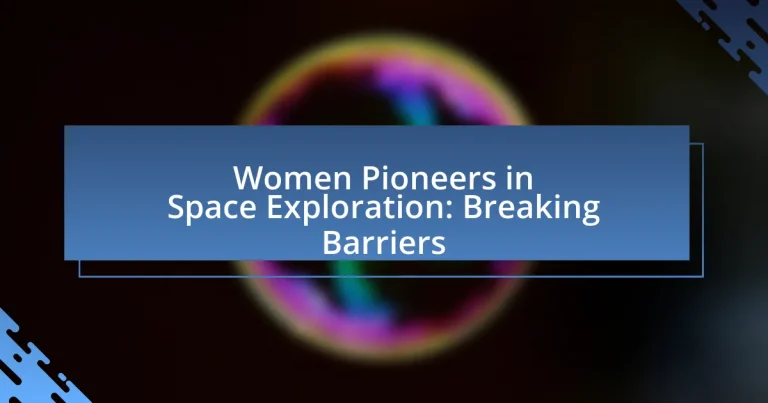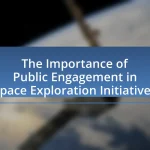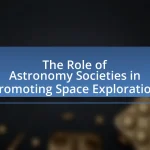Women pioneers in space exploration have played a crucial role in advancing the field, with notable figures such as Valentina Tereshkova, Sally Ride, and Mae Jemison breaking significant barriers. Tereshkova became the first woman in space in 1963, while Ride and Jemison followed as the first American and African American women in space, respectively. The article explores the contributions of these women, the challenges they faced, and their impact on modern space exploration, including the importance of diversity and representation in the field. It also highlights current opportunities for women in space agencies and emerging roles in the commercial space sector, emphasizing the ongoing need for mentorship and education to inspire future generations.
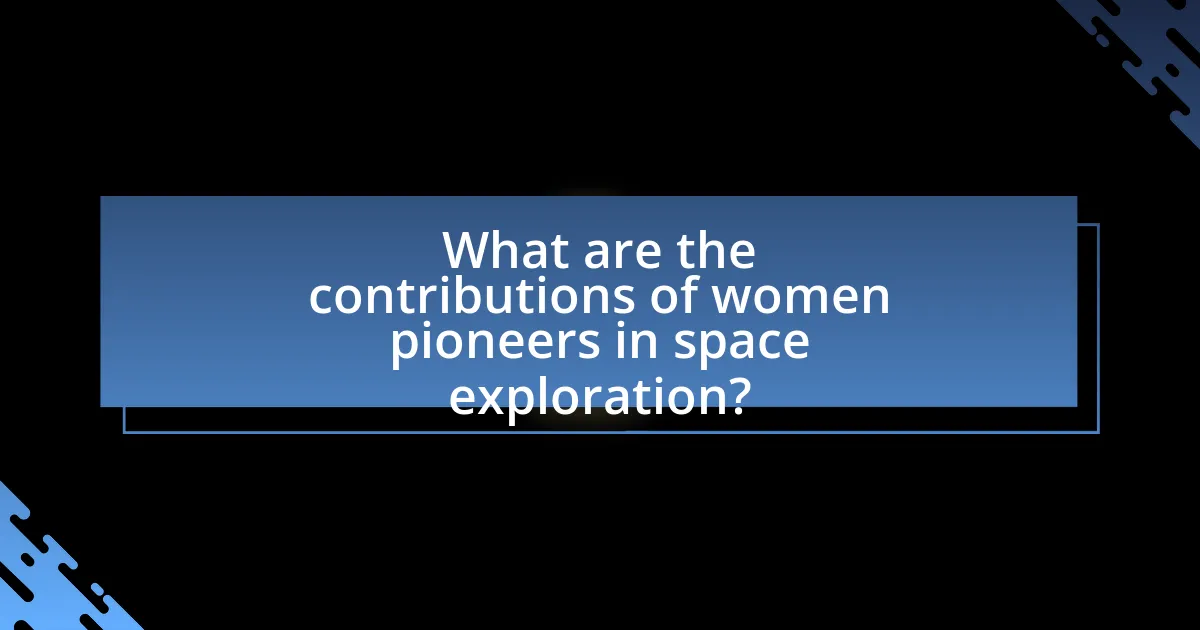
What are the contributions of women pioneers in space exploration?
Women pioneers in space exploration have made significant contributions that have shaped the field. Notably, Valentina Tereshkova became the first woman to fly in space in 1963, orbiting Earth 48 times aboard Vostok 6, which demonstrated women’s capabilities in space missions. Sally Ride followed as the first American woman in space in 1983, contributing to the STS-7 mission aboard the Space Shuttle Challenger, where she conducted experiments and helped pave the way for future female astronauts. Additionally, Mae Jemison became the first African American woman in space in 1992 on the Space Shuttle Endeavour, emphasizing diversity in space exploration. These milestones not only advanced scientific knowledge but also inspired generations of women to pursue careers in STEM fields.
Who are the most notable women in the history of space exploration?
The most notable women in the history of space exploration include Valentina Tereshkova, Sally Ride, Mae Jemison, and Eileen Collins. Valentina Tereshkova became the first woman to fly in space in 1963 aboard Vostok 6, completing 48 orbits around Earth. Sally Ride made history in 1983 as the first American woman in space on the Space Shuttle Challenger. Mae Jemison followed in 1992 as the first African American woman in space, flying on the Space Shuttle Endeavour. Eileen Collins served as the first female commander of a Space Shuttle mission in 1999, leading the STS-93 mission. These women have significantly contributed to breaking barriers in the field of space exploration.
What achievements are attributed to Valentina Tereshkova?
Valentina Tereshkova is primarily recognized as the first woman to fly in space, achieving this milestone on June 16, 1963, aboard the Vostok 6 spacecraft. During her mission, she orbited the Earth 48 times and spent nearly three days in space, which made her the first woman to complete a solo spaceflight. Tereshkova’s flight was significant not only for her personal achievement but also for the Soviet space program, demonstrating the capabilities of women in a field predominantly occupied by men. Her mission contributed to the understanding of the effects of space travel on the female body, paving the way for future female astronauts.
How did Sally Ride impact the perception of women in space?
Sally Ride significantly impacted the perception of women in space by becoming the first American woman to travel to space in 1983. Her historic flight aboard the Space Shuttle Challenger not only showcased women’s capabilities in a male-dominated field but also inspired a generation of girls to pursue careers in science, technology, engineering, and mathematics (STEM). Ride’s achievements challenged stereotypes about women’s roles in space exploration and highlighted the importance of diversity in the astronaut corps. Following her mission, she became a prominent advocate for women in science, further solidifying her influence on societal views regarding women’s contributions to space and STEM fields.
What barriers did women face in the field of space exploration?
Women faced significant barriers in the field of space exploration, primarily including gender discrimination, lack of access to training and opportunities, and societal stereotypes. Gender discrimination manifested in hiring practices and promotion opportunities, often sidelining qualified women in favor of male counterparts. For instance, during the early years of NASA, women were largely excluded from astronaut selection, despite their qualifications, as seen in the case of the Mercury 13, a group of women who underwent astronaut training but were never allowed to fly. Additionally, women encountered limited access to technical education and mentorship, which hindered their advancement in a male-dominated field. Societal stereotypes also played a role, as women were often perceived as less capable in science and engineering, further restricting their participation in space exploration initiatives.
How did societal norms influence women’s participation in space programs?
Societal norms significantly restricted women’s participation in space programs by perpetuating gender stereotypes that deemed women less capable in science and technology fields. Historically, during the mid-20th century, prevailing beliefs emphasized traditional gender roles, which discouraged women from pursuing careers in engineering, mathematics, and the sciences—key areas essential for space exploration. For instance, NASA’s early astronaut selection processes in the 1960s primarily favored male candidates, reflecting societal views that women were unsuitable for such demanding roles. This bias was evident in the exclusion of women from the Mercury 7 astronaut group, despite the qualifications of female pilots like Jerrie Cobb. The gradual shift in societal attitudes, particularly during the feminist movements of the 1970s, began to challenge these norms, leading to increased advocacy for women’s inclusion in STEM fields and space programs. By the 1980s, women like Sally Ride became the first American woman in space, marking a significant change in both societal perceptions and institutional policies regarding women’s roles in space exploration.
What institutional challenges did women encounter in NASA and other agencies?
Women at NASA and other agencies faced significant institutional challenges, including systemic gender discrimination, limited access to career advancement opportunities, and a lack of representation in leadership roles. For instance, during the early years of NASA, women were often relegated to secretarial or support positions, despite their qualifications. The 1960s and 1970s saw women like Katherine Johnson and Mary Jackson breaking through these barriers, yet they still encountered biases that hindered their professional growth. Additionally, studies have shown that women were often excluded from critical projects and decision-making processes, which further perpetuated their marginalization within the organization. These challenges highlight the broader societal norms that affected women’s roles in science and technology during that era.
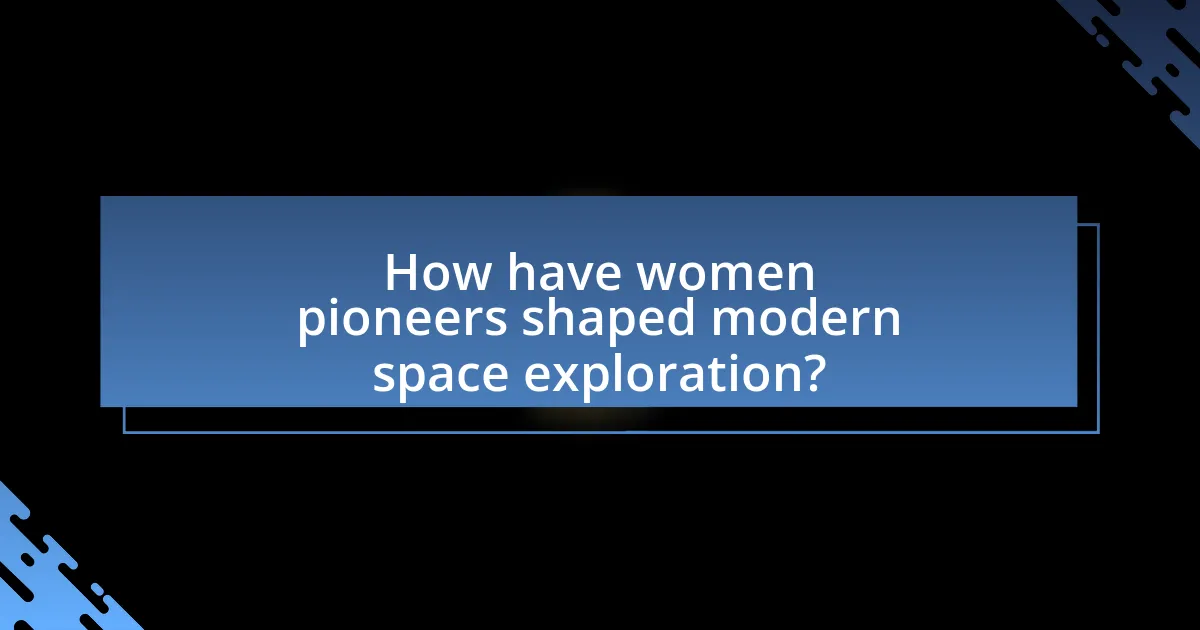
How have women pioneers shaped modern space exploration?
Women pioneers have significantly shaped modern space exploration by breaking barriers and contributing to key advancements in the field. Notable figures such as Valentina Tereshkova, the first woman in space, demonstrated that women could excel in roles traditionally dominated by men, paving the way for future female astronauts. Additionally, Sally Ride became the first American woman in space in 1983, inspiring generations of women to pursue careers in STEM and space-related fields.
Moreover, women like Katherine Johnson, whose calculations were critical to the success of NASA’s early missions, showcased the vital role of women in engineering and mathematics within the space program. Their contributions have led to increased representation and opportunities for women in space exploration, influencing policies and initiatives aimed at promoting gender equality in the aerospace sector. The impact of these pioneers is evident in the growing number of women participating in space missions and leadership roles today.
What roles do women currently hold in space agencies?
Women currently hold a variety of significant roles in space agencies, including positions as astronauts, engineers, scientists, and leadership roles. For instance, NASA has seen women like Jessica Watkins and Jeanette Epps slated for upcoming missions, showcasing their roles as astronauts. Additionally, women serve as mission directors, such as Swati Mohan, who played a key role in the Mars 2020 Perseverance rover landing. Furthermore, women are increasingly represented in engineering and scientific research positions, contributing to advancements in space technology and exploration. According to a 2021 report by the European Space Agency, women made up 30% of the workforce, indicating a growing presence in various capacities within the field.
How are women contributing to leadership positions in space exploration?
Women are significantly contributing to leadership positions in space exploration by taking on key roles in organizations such as NASA, ESA, and private space companies. For instance, NASA’s Artemis program, which aims to return humans to the Moon, is led by women like Administrator Bill Nelson and Deputy Administrator Pam Melroy, who is a former astronaut. Additionally, women like Ellen Ochoa, the first Hispanic woman in space, have paved the way for future generations by holding leadership roles in various capacities, including as the director of NASA’s Johnson Space Center. Statistics show that the percentage of women in senior leadership roles within space agencies has been steadily increasing, with women now holding approximately 30% of leadership positions at NASA. This trend reflects a broader commitment to diversity and inclusion in the field, enhancing innovation and collaboration in space exploration initiatives.
What impact do women scientists and engineers have on space missions?
Women scientists and engineers significantly enhance space missions through their diverse perspectives, innovative problem-solving skills, and leadership roles. Their contributions have been pivotal in various missions, such as NASA’s Mars Rover missions, where women like Swati Mohan played crucial roles in guidance and control, leading to successful landings. Additionally, women have been instrumental in developing technologies and conducting research that advance our understanding of space, exemplified by the work of Katherine Johnson, whose calculations were critical for the success of early spaceflights. The inclusion of women in these roles not only fosters a more inclusive environment but also drives scientific progress and mission success.
Why is diversity important in space exploration?
Diversity is important in space exploration because it enhances problem-solving and innovation by bringing together varied perspectives and experiences. Research shows that diverse teams are more effective at tackling complex challenges, as they can approach problems from multiple angles. For instance, NASA’s Artemis program aims to land the first woman and the next man on the Moon, emphasizing the inclusion of women and underrepresented groups to foster creativity and improve mission outcomes. Studies indicate that organizations with diverse leadership are 35% more likely to outperform their peers, highlighting the tangible benefits of diversity in achieving successful space missions.
How does gender diversity enhance problem-solving in space missions?
Gender diversity enhances problem-solving in space missions by bringing varied perspectives and approaches to complex challenges. Research indicates that diverse teams are more innovative and effective in decision-making, as they combine different experiences and viewpoints, leading to more comprehensive solutions. For instance, a study published in the journal “Nature” found that gender-diverse teams outperform homogeneous teams in problem-solving tasks due to their ability to consider a wider range of options and ideas. This is particularly crucial in space missions, where unforeseen challenges often arise, requiring adaptive and creative responses.
What are the benefits of including women in space exploration teams?
Including women in space exploration teams enhances problem-solving capabilities, fosters diverse perspectives, and improves team dynamics. Research indicates that diverse teams are more innovative and effective; for instance, a study published in the journal “Nature” found that gender-diverse teams outperform homogeneous teams in creativity and decision-making. Additionally, women bring unique experiences and insights that can lead to more comprehensive mission planning and execution. The inclusion of women also reflects a commitment to equality and representation, which can inspire future generations to pursue careers in STEM fields.
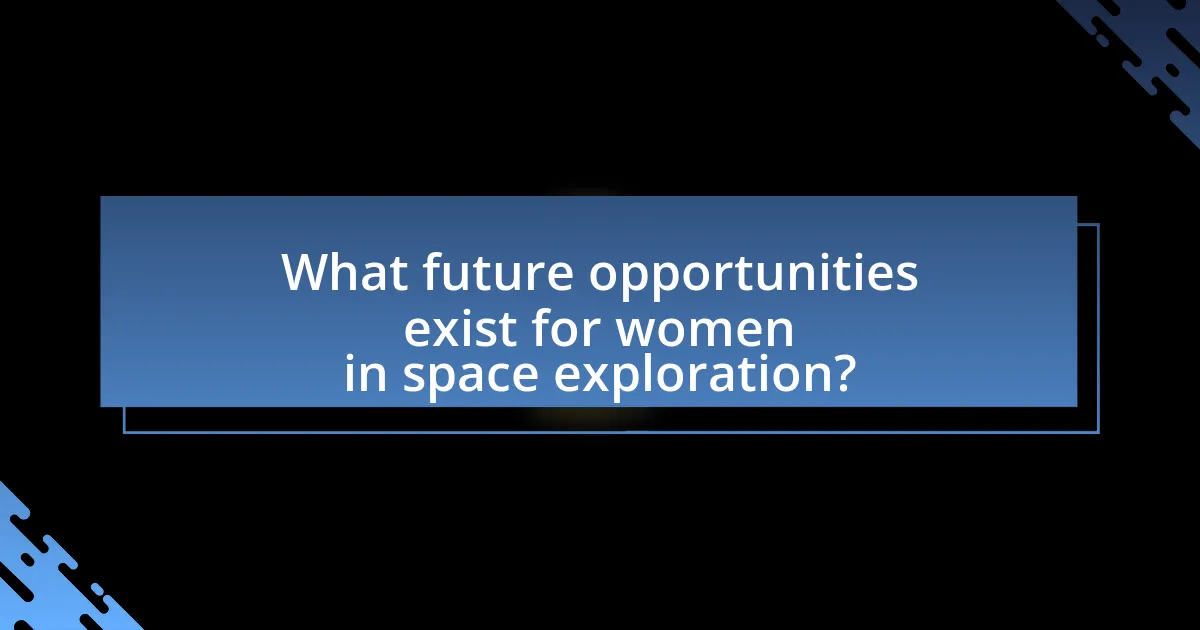
What future opportunities exist for women in space exploration?
Future opportunities for women in space exploration include increased participation in leadership roles, advancements in STEM education tailored for women, and expanded roles in commercial space ventures. Organizations like NASA and private companies are actively promoting diversity initiatives, aiming for gender parity in astronaut selections and mission leadership. For instance, NASA’s Artemis program plans to land the first woman on the Moon by 2024, highlighting a commitment to inclusivity. Additionally, the growing commercial space sector, exemplified by companies like SpaceX and Blue Origin, is creating new career paths in engineering, research, and operations specifically targeting women. These initiatives are supported by data showing that diverse teams enhance innovation and problem-solving, making women’s involvement crucial for the future of space exploration.
How can young women be encouraged to pursue careers in space science?
Young women can be encouraged to pursue careers in space science through targeted mentorship programs and educational initiatives. Programs that connect young women with female role models in the field, such as astronauts and scientists, have been shown to increase interest and confidence in pursuing STEM careers. For instance, the National Aeronautics and Space Administration (NASA) has implemented initiatives like the “Women in STEM” program, which aims to inspire young girls by showcasing successful women in space science. Additionally, research indicates that girls who participate in hands-on science activities and receive encouragement from educators are more likely to pursue related careers. According to a study published in the journal “Science,” girls who engage in STEM-related extracurricular activities are 1.5 times more likely to consider a career in these fields.
What educational programs are available to inspire future female astronauts?
Educational programs available to inspire future female astronauts include NASA’s Artemis program, which actively encourages female participation in space exploration through mentorship and outreach initiatives. Additionally, the Girl Scouts of the USA offers STEM programs that focus on space science, while organizations like the Space Foundation provide scholarships and educational resources specifically aimed at young women interested in aerospace careers. These programs are designed to empower girls by providing hands-on experiences and role models in the field of space exploration.
How can mentorship programs support women in STEM fields related to space?
Mentorship programs can support women in STEM fields related to space by providing guidance, networking opportunities, and role models. These programs connect women with experienced professionals who can offer insights into career paths, technical skills, and industry challenges. Research indicates that mentorship significantly increases retention rates for women in STEM, with a study by the National Science Foundation showing that women with mentors are more likely to pursue advanced degrees and leadership roles in their fields. Additionally, mentorship fosters a sense of belonging and confidence, which is crucial in male-dominated areas like space exploration.
What are the emerging fields in space exploration that women can lead?
Emerging fields in space exploration that women can lead include astrobiology, space robotics, and space policy development. Astrobiology focuses on the search for extraterrestrial life and the study of life’s potential in extreme environments, an area where women like Dr. Sara Seager have made significant contributions. Space robotics involves the design and operation of robotic systems for exploration, with women such as Dr. Jennifer A. Lewis leading advancements in this technology. Additionally, space policy development is crucial for shaping the future of space exploration, and women like Dr. Ellen Stofan are influential in this domain, advocating for sustainable practices and international collaboration. These fields not only highlight women’s leadership but also their critical roles in advancing space exploration initiatives.
How is the commercialization of space creating new roles for women?
The commercialization of space is creating new roles for women by expanding opportunities in various sectors such as engineering, entrepreneurship, and research. As private companies like SpaceX and Blue Origin enter the space industry, they require diverse talent, leading to increased recruitment of women in technical and leadership positions. For instance, NASA’s Artemis program aims for gender parity in its workforce, with women holding key roles in mission planning and execution. This shift is evidenced by the growing number of women in STEM fields related to space, with organizations like the Space Data Association reporting a rise in female participation in space-related projects.
What advancements in technology are opening doors for women in space exploration?
Advancements in technology such as improved spacecraft design, enhanced simulation training, and the rise of private space companies are significantly opening doors for women in space exploration. Enhanced spacecraft design, including more ergonomic and user-friendly interfaces, allows for greater inclusivity and accessibility, enabling women to participate more effectively in missions. Additionally, advanced simulation training programs are tailored to diverse learning styles, which helps women gain the necessary skills and confidence for space missions. The emergence of private space companies, like SpaceX and Blue Origin, has created more opportunities for women by diversifying the workforce and promoting gender equality in hiring practices. These advancements collectively contribute to a more inclusive environment in the field of space exploration.
What practical steps can women take to break into the space industry?
Women can break into the space industry by pursuing relevant education, gaining experience through internships, and networking within the field. Specifically, obtaining degrees in fields such as aerospace engineering, astrophysics, or computer science equips women with the necessary technical skills. According to the American Institute of Aeronautics and Astronautics, women represent only about 20% of the aerospace workforce, highlighting the need for increased participation.
Additionally, securing internships at organizations like NASA or private aerospace companies provides practical experience and enhances employability. Networking through professional organizations, such as the Society of Women Engineers, can also create opportunities for mentorship and collaboration, further supporting women’s entry into the space sector.
